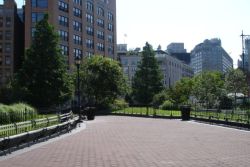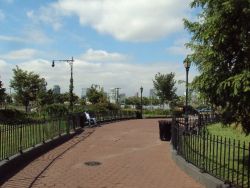Canal Park
Canal Park
This park was among the city’s first public spaces, officially recognized since 1686. At that time, it took its name from an actual canal that Canal Street later replaced. On October 12, 1920, the governors of New York and New Jersey met here to break ground for the Holland Tunnel. The 234-year-old park became a construction site and then a parking lot, until the local community’s dream to restore the historic park became a reality in 2005.
From the time the first colonists arrived in New York in 1624 until the grid plan took effect in Manhattan in 1811, the city’s streets and squares evolved without a plan. People gathered to do business, talk and recreate wherever it suited them. On April 27, 1686, Thomas Dongan, the colony’s newly appointed governor, granted a new charter that gave control of vacant, unclaimed lands to the Common Council (an early predecessor of the City Council).
Manhattan’s development did not reach here until the early 19th century, and by 1833 this triangle served as one of many public markets. Officially known as the Clinton Country Market from 1849 to 1860, it then stood on the north side of Canal Street until 1903. In 1871 the newly created Department of Public Parks took control of all pre-existing squares, and Canal Park received new sidewalks, a perimeter fence (relocated from City Hall Park), trees and shrubs. From that time until 1891, the pavement surrounding the park served as the city’s Flower Market.
Landscape architects Calvert Vaux and Samuel Parsons, Jr. redesigned the park with a distinctively shaped path in 1888. The park maintained this layout until it housed pumps that provided pressurized air to workers in the tunnel’s construction caissons. After the Holland Tunnel opened, the park was not restored. In 1930 it was surrendered to the Manhattan Borough President’s office to aid in the construction of the elevated West Side Highway. For the remainder of the 20th century, the site served as a parking lot.
A group of community activists called the Canal West Coalition discovered the site’s history and in 2000 won a case against the State Department of Transportation to make it a park once again. The park design replicates the pathway of 1888 and contains a decorative planter with engraved images of the original park. For much of the 20th century, Canal Park’s intended purpose as a public space was forgotten. At the turn of the new millennium it was restored to its original purpose as a park in a layout that respects its history.
Check out your park's Vital Signs
Clean & Safe
Green & Resilient
Empowered & Engaged Users
Share your feedback or learn more about how this park is part of a
Vital Park System


